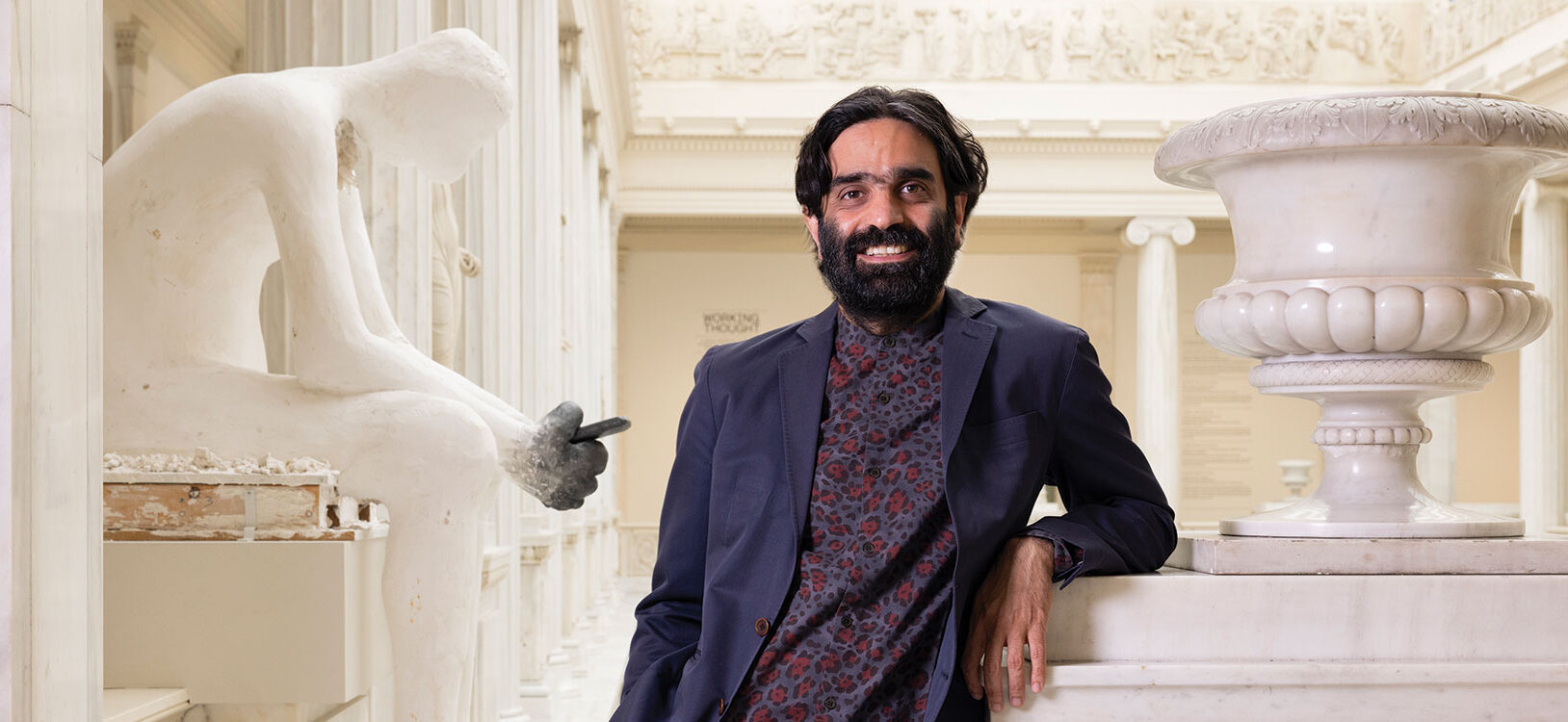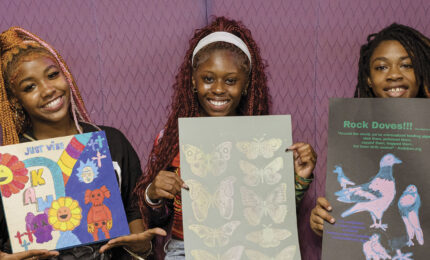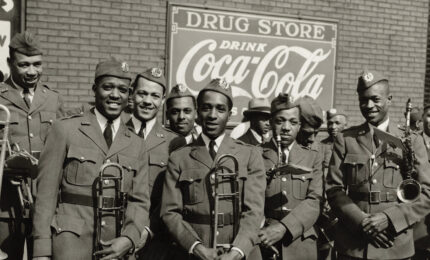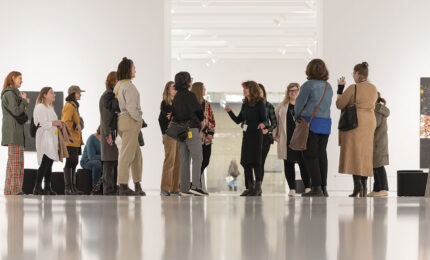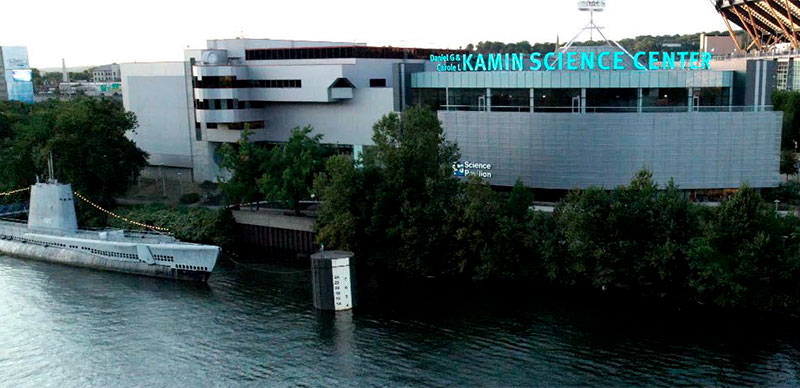The Carnegie International has always been about connecting Pittsburgh to the world through art. Indeed, its namesake Andrew Carnegie hoped the exhibition would make the city “as famous for art as it is now for steel.”
But as Sohrab Mohebbi relocated to Pittsburgh from New York City to consider the global exhibition he would bring here as the Kathe and Jim Patrinos Curator of the 58th International, the world was plunging deeper into a global pandemic that would test notions of international togetherness.
Mohebbi was not only undeterred but he also quickly determined that the story of the International is not about one place or moment in time. Rather, the story he sees extends through the exhibition’s 125-year history and reflects a special dynamic with its host city.
“The International is really not about one edition or one curator or one team that works on it. It’s really about this legacy and its history,” he says. “I think what’s really important is for the city to acknowledge it, which I think it does for the most part, but also become its ambassador. I think it’s important for all of us who go out in this world to say, ‘This is the city that hosts, essentially, one of the oldest international exhibitions in the world.’”
The Carnegie International, the longest-running survey of contemporary art in North America, has been Carnegie Museum of Art’s signature exhibition since its establishment in 1896, predated by the Venice Biennale by just a year.
“The 58th Carnegie International team has catalyzed international curatorial research at a level that is unprecedented for this 125-year-old exhibition series.”
-Eric Crosby, The Henry J. Heinz II Director of Carnegie Museum of Art
Opening on September 24 and running through April 2, 2023, the 58th Carnegie International will bring together new commissions, existing works, and projects by established and emerging artists working from across the globe. And, as is the modern tradition of the International, it will examine how art and artists are responding to critical issues of our time. Today, that includes topics such as migration, appropriation, expropriation, and decolonization.
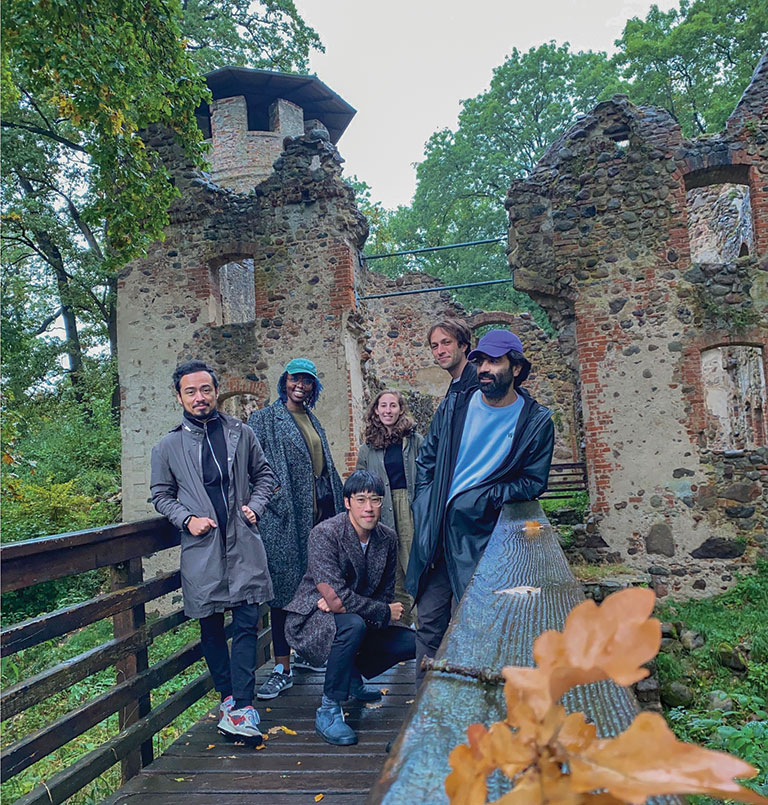
At the 2021 curatorial retreat in Gnevkow, Germany, are (left to right) Pablo José Ramírez, Renée Akitelek Mboya, Ryan Inouye, Talia Heiman, Robert M. Ochshorn, and Sohrab Mohebbi.
Mohebbi hand-picked each artist, assisted by an in-house curatorial team and a diverse group of curatorial counselors. He’s spent a lifetime preparing for a role like this. Mohebbi grew up among the arts, often visiting Tehran Museum of Contemporary Art, one of the largest art museums in Iran. He also experienced the arts at home. His mother hosted an informal gallery in her living room after the 1979 revolution shuttered most of Tehran’s galleries. As he grew older, Mohebbi became a guitarist and singer with a band called 127—even visiting Pittsburgh in 2008 for a show at Brillobox in the city’s Bloomfield neighborhood. He visited the city a few other times since then before moving here in 2020.
Mohebbi says he’s drawn to Pittsburgh for both its history and its future.
“The city’s a survivor, and there’s a lot to be learned from that,” he says. “All these different historical periods—from the height of industrialization to the demise of the steel industry—and how the city has come back. It’s really an American story, and an urban story, and a human story.”
As curator of the 58th Carnegie International, Mohebbi is now a part of that story, and he hopes the stories told through the International will resonate with fellow Pittsburghers.
“I don’t want to be the person who comes from outside and says something about the city because I think that’s disingenuous,” Mohebbi says. “But my relationship with Pittsburgh has been one of discovery, of meeting people that I feel will be always part of my life, and of working on a project that is so transformative for me. And I do hope it’ll be this tiny bit transformative for others.”
What Is International?
While the COVID-19 pandemic restricted movement in so many ways, Mohebbi spent a lot of time thinking about the concept of movement in his curatorial process.
“What is international? How do we think about ‘international’ from the U.S.? What is the geopolitical imprint of the U.S. since 1945?” he asks. “That was a way to think about movements of people, of ideas, of objects, and of images.”
Those guiding questions helped define the scope of work for Mohebbi, though he’s hesitant to ascribe a vision for the 58th Carnegie International because he wants it to speak for itself.
“I don’t think I have one core vision because I think that’s so misleading,” he says. “And because, in the end, curating brings artworks together. And I think the artworks bring the vision and speak for themselves.”
With shows canceled around the world, Mohebbi acknowledges that artists faced financial strife, along with the universally felt fears brought on by a once-a-century pandemic. Some of the works in the International will respond directly to the global health crisis, he notes, adding that the impact of the pandemic may become more noticeable in the works as the years wear on.
“I don’t think I have one core vision because I think that’s so misleading. And because, in the end, curating brings artworks together. And I think the artworks bring the vision and speak for themselves.”
-Sohrab Mohebbi, the Kathe and Jim Patrinos Curator of the 58th Carnegie International
But Mohebbi asserts that the experience of being an artist may have helped many artists endure the isolation inflicted by COVID-19. Artists are already accustomed to working in solitude in their studios, he notes, while non-artists were plunged into unfamiliar solitary lifestyle due to social distancing.
“More people started to live their lives like artists, especially in the first chapter of the pandemic,” he says. “People are like, ‘What do we do with our time and how do we use it?’ Those questions are artistic questions. Artists go to the studio and what do they do? You make your life, you create your life. In that way, I feel like artists were more equipped to live under these conditions. With that said, even if art is created in solitude, it’s a social project. It’s dialogical. So, it would be unfair to say they were just doing what they were doing.”
Creating International Conversations
Curating the International is a Herculean task in normal times. Mohebbi and his team embraced the added challenge posed by the pandemic.
“Curatorial practice was not the only thing that had to reinvent itself during the pandemic,” he says. “We all had to face it one way or the other. I think it kind of became the infrastructure. In a way, you couldn’t escape it.”
Mohebbi first formed a curatorial council comprising experts Freya Chou of Hong Kong, Renée Akitelek Mboya of Kenya, Robert M. Ochshorn of San Francisco, and Pablo José Ramírez of Guatemala/Amsterdam. The group was uniquely positioned to consult on the International, bringing backgrounds in curation, writing, filmmaking, software engineering, and cultural theorizing, along with lived experiences in Hong Kong, Guatemala, Amsterdam, and Nairobi. Those varied experiences helped to shape and challenge expectations of an international exhibition in America.
“The 58th Carnegie International team has catalyzed international curatorial research at a level that is unprecedented for this 125-year-old exhibition series,” says Eric Crosby, the Henry J. Heinz II Director of Carnegie Museum of Art. “Sohrab and his collaborators—dispersed around the globe—worked to realize an exhibition that will be expansive in its geopolitical scope as well as responsive to local concerns. Their research will have a lasting impact on the legacy of the Carnegie International and the future of our museum.”
As the International team worked to decide on their slate of artists, the council introduced artists to the curators, helped contextualize their work, served as a sounding board for ideas, filled in gaps in history, offered fresh perspectives, and unveiled insights into artists’ local communities.
“It’s really important to have people to reach out to that had a feel for what was happening where they were, on the ground, so to speak,” Ryan Inouye, the International’s associate curator, explains. Relying on that bench of advisers allowed the Pittsburgh-based curatorial team to get a feel for a place, even if they couldn’t physically be there.
Mohebbi hired Inouye as associate curator knowing that his experience working with international shows would strengthen the 58th Carnegie International. Inouye most recently worked as senior curator at Sharjah Art Foundation in Sharjah, United Arab Emirates.
It’s full-circle for Inouye, as the 2008 Carnegie International was the first large-scale international exhibition he ever experienced. Inouye recalls how the exhibition sparked his thinking about “how international perspectives and ideas and art could come together in one space and create a larger conversation.”
Working amidst an international health crisis underscored how important it is to build relationships with a community of artists and colleagues, Inouye notes. The Pittsburgh team’s curatorial assistant, Talia Heiman, for example, brings experience in curating at the Center for Contemporary Art in Tel Aviv and the Institute of Contemporary Art at the University of Pennsylvania in Philadelphia.
Mohebbi, of course, brought his own deep knowledge of curation. He came to the post as curator-at-large of the SculptureCenter in New York City, where he will return as director later this year. He’s worked in curation and advising at arts organizations in Los Angeles, Minneapolis, Joshua Tree, Amsterdam, Istanbul, and South Africa.
Though some of the team’s meetings were relegated to Zoom, Mohebbi says he was able to travel to visit artists for masked, outdoor meetings in Guatemala, Panama, and El Salvador. The curatorial council also met up in Germany.
Now that the artists are selected and will soon be announced, the team will spend the summer supporting artists in production, from framing works to helping with shipping large pieces. Sohrab and his team will also determine the exhibition layout in the museum spaces.
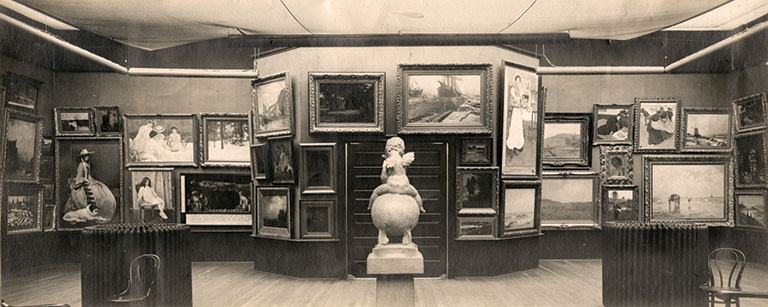
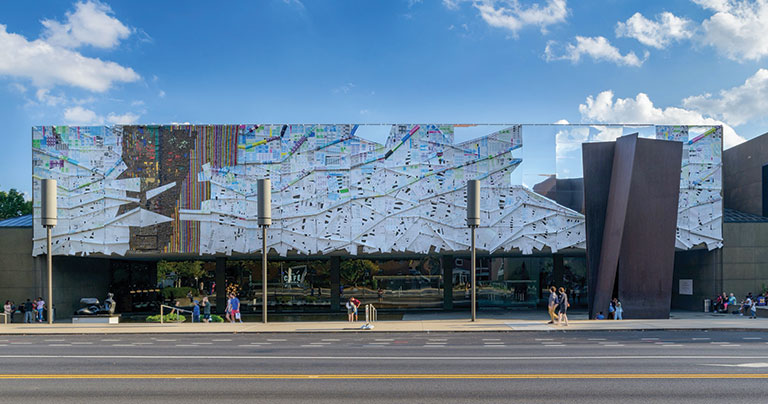
The Carnegie International has spanned 125 years and taken many forms. Top photo: an installation view of 1904’s Ninth Annual Exhibition, as it was known then. Above: El Anatsui’s Three Angles covering the façade of Carnegie Museum of Art as part of the 2018 Carnegie International.
Since the first Carnegie International, the museum has acquired hundreds of works of art that have appeared in the exhibition series, including works by Josef Albers, Dara Birnbaum, Louise Bourgeois, Mary Cassatt, Nicole Eisenman, Isa Genzken, Winslow Homer, Edward Hopper, Mike Kelley, Ellsworth Kelly, Louise Lawler, Julie Mehretu, Joan Miró, Bruce Nauman, Chris Ofili, Sigmar Polke, Auguste Rodin, Doris Salcedo, John Singer Sargent, Hiroshi Sugimoto, James Abbott McNeill Whistler, and Lynette Yiadom-Boakye. Prizes awarded to Carnegie International artists include the Carnegie Prize for outstanding achievement in the exhibition in the context of a lifetime of work, and the Fine Prize for an emerging artist.
Mohebbi is quick to point out Carnegie Museum of Art’s long legacy of bringing the world’s best and brightest to Pittsburgh, and building its esteemed collection from the works of many International artists. He notes that the Pittsburgh museum is older than New York City’s vaunted Museum of Modern Art. So, too, is the Carnegie International.
“If we think about exhibition-making or contemporary art in the United States,” he says, “it’s this.”
Taking The International Beyond The Museum Walls
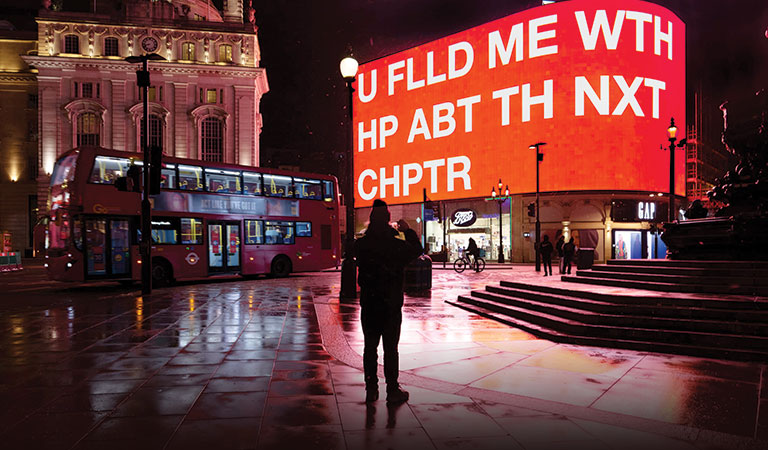
Tony Cokes, Exhibition view 4 Voices / 4 Weeks, CIRCA, London, 2021
The full cast of the 58th Carnegie International artists won’t be made public until the months leading up to the show. But in March, the museum announced five commissions that, according to Sohrab Mohebbi, the Kathe and Jim Patrinos Curator of the International, “expand the scope of the exhibition beyond the walls of this museum; establish relationships with local partners and artists to connect local concerns with current issues prompting national and international debates; and collaborate with other national and international museums.”
terra0, a Berlin-based artist collective, will create an augmented tree that owns its land—to be planted on a plot of land donated by Community College of Allegheny County on the Northside. “The tree will be granted ownership of the land that it’s planted on and regulate and govern itself through a smart contract by blockchain technology,” Mohebbi explains. “In exchange for services like upkeep, watering, pruning, the tree will mint what they call ‘Certificates of Care’ that will be given to the museum. This project is particularly relevant to Pennsylvania, which lost a large percentage of its forest to the logging industry in the 19th and 20th centuries. It’s really at the intersection of art, technology, and ecology.”
James “Yaya” Hough will paint a mural in Pittsburgh’s historic Hill District, the neighborhood where he was born. He’s working with Nafasi, an art and community development initiative in the Hill District, which has been hosting community workshops in the lead-up to the mural unveiling. A selection of Hough’s works will be presented in the museum galleries during the Carnegie International.
Rafael Domenech, a Cuban American artist, will create an ellipse-shaped pavilion in the museum’s Sculpture Court in time for its Inside Out event series this summer. Construction scaffolding and mesh will make up the shape of the structure, encouraging viewers to think about the signs of urban development and the sites of museums as places for production.
Tony Cokes’ artwork will brighten up the drive for commuters on Route 28 with four digital billboards. Cokes’ signature style mixes moving text, still images, and multichromatic color blocks. The texts are fragments of speeches, writings, and lyrics collected from a range of sources, including politicians, comedians, and cultural theorists, addressing a range of topics like racism, evil, imperialism, megalomania, and capital. A video installation of the Rhode Island-based artist’s work will also be on view at Carnegie Museum of Art.
International partners will be key in contextualizing contemporary voices, and one featured partner will be Museo de la Solidaridad Salvador Allende, a museum of modern and contemporary art in Chile, with one of the most important collections in Latin America. Carnegie Museum of Art will present a selection of the museum’s extensive collection for the first time in the United States.
The 58th Carnegie International, presented by Bank of America, is made possible by leadership support from Kathe and Jim Patrinos.
Major support is provided by the Carnegie International Endowment, The Fine Foundation, the Jill and Peter Kraus Endowment for Contemporary Art, and the Carnegie Luminaries. Significant support is provided by Teiger Foundation, The Andy Warhol Foundation for the Visual Arts, The Susan J. and Martin G. McGuinn Exhibition Fund, and the Keystone Members of the Carnegie International.
The 58th Carnegie International has been made possible in part by the National Endowment for the Humanities. This project is supported in part by the National Endowment for the Arts. Generous support is provided by the The Heinz Endowments, the Heinz Family Foundation, the Louisa S. Rosenthal Family Fund, and the Friends of the Carnegie International.
Additional support is provided by the Akers Gerber Foundation, Carnegie Mellon University School of Art, Buchanan Ingersoll and Rooney, Highmark Blue Cross Blue Shield and Allegheny Health Network, NOVA Chemicals, Sotheby’s, Fort Pitt Capital, the Henry Moore Foundation, Advanced Auto Parts, Giant Eagle Foundation, UPMC and UPMC Health Plan, the Japan Foundation, the Fans of the Carnegie International, and the Carnegie Collective.
This program is supported as part of the Dutch Culture USA program by the Consulate General of the Netherlands in New York. This exhibition is supported by Etant donnés Contemporary Art, a program from Villa Albertine and FACE Foundation, in partnership with the French Embassy of the United States.
